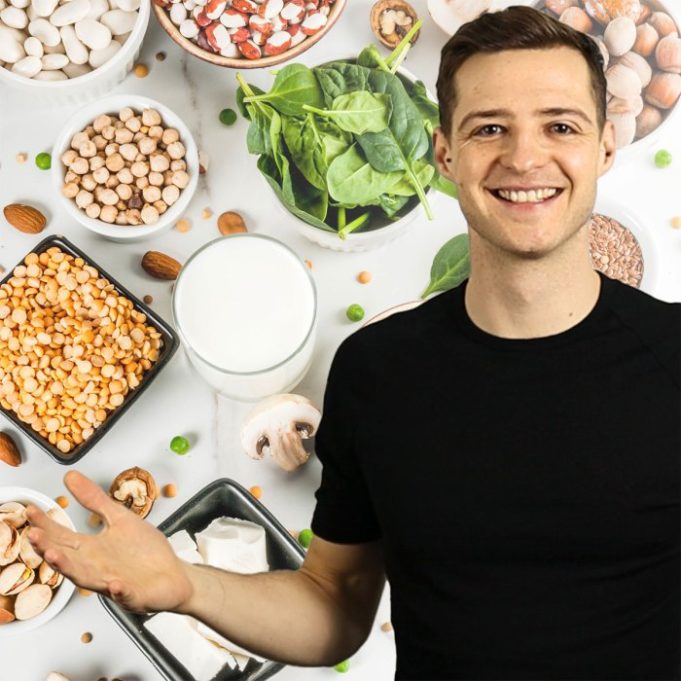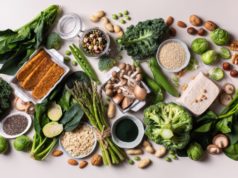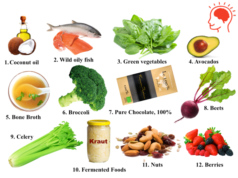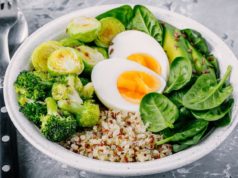How to increase protein intake in vegetarian diet – How to increase protein intake in a vegetarian diet is a common question, especially for those seeking a balanced and nutritious lifestyle. While many associate protein with meat, there are plenty of plant-based options to fuel your body and meet your daily needs. This guide will delve into the world of vegetarian protein, exploring various food sources, meal planning tips, and even the role of supplements.
From understanding your individual protein requirements to discovering creative ways to incorporate protein into your meals, this comprehensive guide will equip you with the knowledge and tools to ensure you’re getting enough protein while embracing a vegetarian diet.
Protein-Rich Vegetarian Food Sources: How To Increase Protein Intake In Vegetarian Diet
A vegetarian diet can provide all the essential nutrients, including protein, when planned thoughtfully. You can find protein in various plant-based foods, including legumes, grains, nuts, and seeds. Understanding the different types of protein sources and how to combine them is crucial for meeting your protein needs.
Complete Protein Sources
Complete protein sources contain all nine essential amino acids that your body needs but cannot produce on its own. These sources are essential for vegetarians as they provide a full range of amino acids in a single serving.
- Soy Products: Tofu, tempeh, edamame, and soy milk are excellent sources of complete protein. Soy products are also rich in iron, calcium, and fiber.
- Quinoa: This ancient grain is a complete protein source and is also high in fiber, iron, and magnesium.
- Chia Seeds: These tiny seeds are packed with protein, fiber, and omega-3 fatty acids. They can be added to smoothies, yogurt, or oatmeal.
Incomplete Protein Sources
Incomplete protein sources lack one or more essential amino acids. While they don’t provide a complete amino acid profile, they are still valuable sources of protein and can be combined to create a complete protein meal.
- Legumes: Beans, lentils, peas, and chickpeas are excellent sources of protein, fiber, and iron. They are versatile and can be used in soups, stews, salads, and dips.
- Nuts and Seeds: Almonds, walnuts, cashews, pumpkin seeds, and sunflower seeds are good sources of protein, healthy fats, and fiber. They can be enjoyed as snacks or added to meals.
- Grains: Brown rice, oats, and barley are good sources of protein and fiber. They can be combined with legumes or nuts to create complete protein meals.
Combining Incomplete Protein Sources
To obtain all essential amino acids from incomplete protein sources, it is important to combine them strategically throughout the day. The following are some examples of complementary protein combinations:
- Beans and Rice: This classic combination provides a complete protein profile.
- Lentils and Quinoa: This combination is rich in protein, fiber, and iron.
- Peanut Butter and Whole Wheat Bread: This combination provides a complete protein profile and is a great source of energy.
Vegetarian Protein Sources by Food Group, How to increase protein intake in vegetarian diet
The following table showcases diverse vegetarian protein sources categorized by food group:
| Food Group | Examples | Protein per Serving (grams) |
|---|---|---|
| Legumes | Black beans, chickpeas, lentils, kidney beans | 15-20 grams per cup (cooked) |
| Grains | Quinoa, brown rice, oats, barley | 5-8 grams per cup (cooked) |
| Nuts and Seeds | Almonds, walnuts, pumpkin seeds, sunflower seeds | 5-8 grams per ounce |
| Soy Products | Tofu, tempeh, edamame | 20-30 grams per serving |
| Vegetables | Broccoli, spinach, asparagus, Brussels sprouts | 2-4 grams per cup (cooked) |
Vegetarian Protein Supplements
While a balanced vegetarian diet can provide ample protein, supplements can be a helpful tool to ensure adequate intake, especially for athletes, individuals with specific dietary needs, or those seeking to increase muscle mass.
Types of Vegetarian Protein Supplements
Vegetarian protein supplements are derived from plant-based sources and offer a convenient way to boost protein intake. Here are some popular options:
- Soy Protein Isolate: Soy protein isolate is a highly concentrated form of protein extracted from soybeans. It’s a complete protein, meaning it contains all nine essential amino acids. Soy protein isolate is often used in protein powders, bars, and other supplements.
- Pea Protein: Pea protein is derived from peas and is a popular choice for those with soy allergies or sensitivities. It’s also a complete protein and is often used in protein powders, bars, and plant-based meat alternatives.
- Brown Rice Protein: Brown rice protein is a hypoallergenic option derived from brown rice. It’s a good source of essential amino acids, but it’s not a complete protein, meaning it lacks one or more essential amino acids. Brown rice protein is often used in protein powders and bars.
- Hemp Protein: Hemp protein is derived from hemp seeds and is a complete protein. It’s a good source of essential amino acids, fiber, and omega-3 fatty acids. Hemp protein is often used in protein powders, bars, and plant-based milk alternatives.
- Quinoa Protein: Quinoa is a complete protein and is a good source of fiber, iron, and magnesium. Quinoa protein is often used in protein powders, bars, and plant-based meat alternatives.
Nutritional Profiles of Vegetarian Protein Supplements
Vegetarian protein supplements vary in their nutritional profiles, with different amino acid profiles, fiber content, and potential allergens.
- Soy Protein Isolate: Soy protein isolate is a highly concentrated source of protein, with a high biological value (BV) of 90-95, indicating its high digestibility and absorption rate. It also contains a good amount of branched-chain amino acids (BCAAs), which are essential for muscle growth and repair.
- Pea Protein: Pea protein is a good source of protein with a BV of 75-80. It’s also a good source of BCAAs, iron, and fiber.
- Brown Rice Protein: Brown rice protein has a BV of 60-70. It’s a good source of protein, fiber, and iron, but it’s lower in BCAAs compared to soy and pea protein.
- Hemp Protein: Hemp protein has a BV of 75-80. It’s a good source of protein, fiber, and omega-3 fatty acids. It also contains a good amount of BCAAs.
- Quinoa Protein: Quinoa protein has a BV of 75-80. It’s a good source of protein, fiber, iron, and magnesium. It also contains a good amount of BCAAs.
Choosing the Right Vegetarian Protein Supplement
The best vegetarian protein supplement for you will depend on your individual needs and preferences. Consider factors such as your dietary restrictions, taste preferences, and goals.
Tips for Increasing Protein Intake
Maximizing protein intake in a vegetarian diet requires strategic planning and incorporating protein-rich foods throughout the day. By understanding the basics of protein sources and implementing practical tips, you can ensure you meet your daily protein needs while enjoying a delicious and diverse vegetarian diet.
Incorporating Protein into Meals and Snacks
To effectively increase protein intake, it is important to incorporate protein-rich foods into all meals and snacks. This ensures a steady supply of protein throughout the day, supporting muscle growth and repair, satiety, and overall health.
- Breakfast: Start your day with a protein-packed breakfast, such as a tofu scramble with vegetables, a smoothie with protein powder and fruit, or overnight oats with chia seeds and nuts.
- Lunch: Opt for protein-rich lunch options like lentil soup, quinoa salad with chickpeas, or a veggie burger on a whole-wheat bun.
- Dinner: Include a variety of protein sources in your dinner, such as beans, lentils, tempeh, or seitan. Experiment with different recipes and cooking methods to keep meals interesting.
- Snacks: Keep protein-rich snacks on hand for when hunger strikes. Good choices include nuts, seeds, edamame, Greek yogurt, or a handful of trail mix.
Recipes for Vegetarian Protein
Many delicious and nutritious vegetarian recipes incorporate protein-rich ingredients, making it easy to increase your protein intake without sacrificing flavor.
- Lentil Curry: This hearty and flavorful curry is packed with protein from lentils and vegetables. Serve it with brown rice or quinoa for a complete meal.
- Tofu Stir-Fry: Tofu is a versatile protein source that can be used in countless dishes. This stir-fry combines tofu with your favorite vegetables and a flavorful sauce.
- Black Bean Burgers: These plant-based burgers are a delicious and satisfying alternative to traditional beef burgers. They can be served on buns or in salads.
- Chickpea Salad Sandwiches: This classic sandwich filling is made with chickpeas, vegetables, and a creamy dressing. It’s a great way to enjoy a protein-rich lunch or snack.
Balancing Your Diet
While protein is essential, it’s important to consume a balanced diet that includes other essential nutrients, such as carbohydrates, fats, vitamins, and minerals.
- Carbohydrates: Provide energy for your body and are found in whole grains, fruits, and vegetables.
- Fats: Essential for hormone production, cell function, and nutrient absorption. Choose healthy fats from sources like avocados, nuts, seeds, and olive oil.
- Vitamins and Minerals: Crucial for various bodily functions. Ensure a diverse diet that includes a wide range of fruits, vegetables, and whole grains.
It’s important to note that the optimal protein intake varies depending on factors such as age, activity level, and overall health. Consulting a registered dietitian or nutritionist can help you determine the appropriate protein intake for your individual needs.
Last Recap
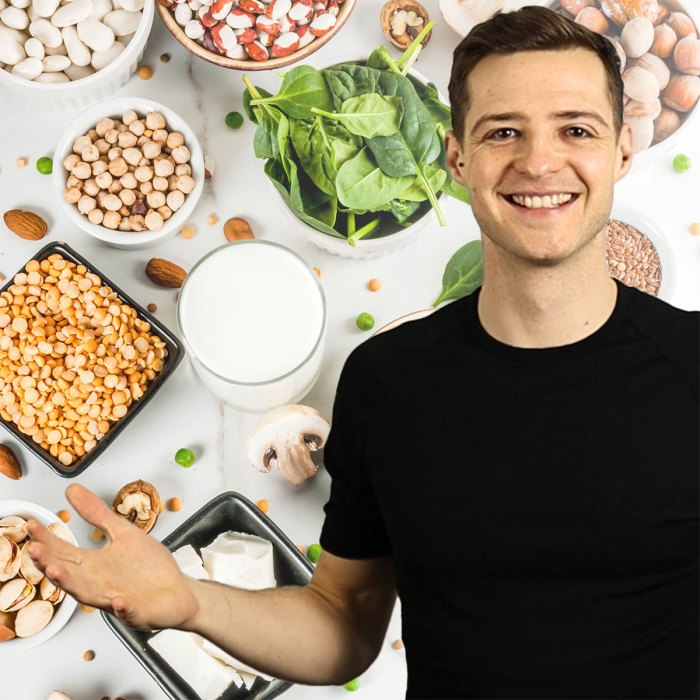
By understanding your protein needs, exploring diverse vegetarian food sources, and incorporating smart strategies into your daily routine, you can confidently build a fulfilling and protein-rich vegetarian diet. Remember, a balanced approach that includes a variety of plant-based protein sources, alongside other essential nutrients, is key to achieving optimal health and well-being.
FAQ Insights
Is it possible to get enough protein on a vegetarian diet?
Absolutely! With a variety of plant-based protein sources, you can easily meet your daily protein needs. It’s all about making informed choices and incorporating diverse protein-rich foods into your meals.
What are some easy ways to increase protein in vegetarian meals?
Adding legumes like lentils or chickpeas to soups and stews, incorporating tofu or tempeh into stir-fries, and sprinkling chia seeds on salads are simple ways to boost protein.
Are protein supplements necessary for vegetarians?
While protein supplements can be helpful for some individuals, they are not essential for most vegetarians. A balanced diet rich in plant-based protein sources should suffice.
Increasing protein intake in a vegetarian diet can be achieved by incorporating plenty of legumes, tofu, tempeh, and nuts. These protein-rich foods also happen to be low in saturated fat, which is a key factor in how to reduce cholesterol with diet.
By focusing on these plant-based protein sources, you can nourish your body while maintaining healthy cholesterol levels.
Boosting protein intake on a vegetarian diet can be as simple as incorporating more beans, lentils, tofu, and nuts into your meals. It’s also important to remember that a balanced diet is crucial for overall health, so consider exploring what is the best diet for overall health to get a better understanding of what works best for you.
Ultimately, increasing protein intake in a vegetarian diet should be a part of a holistic approach to nutrition, ensuring you get all the essential nutrients your body needs.
Boosting your protein intake on a vegetarian diet can be as simple as incorporating more legumes, tofu, and nuts into your meals. If you’re new to dietary changes, a good place to start is to learn the basics of healthy eating, such as portion control and mindful snacking.
You can find a helpful guide on how to start dieting for beginners. Once you’ve got the basics down, experiment with different protein-rich vegetarian recipes to find what you enjoy most!















